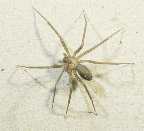|
|
Steve Tvedten's "The Bug Stops Here" |
|
|
Steve Tvedten's "The Bug Stops Here" |
The brown recluse spider is shy, sedentary and builds an irregular web that is often not even recognized as a spider web. Females lay eggs in flattened egg sacs that are frequently attached to the underside of objects. Mating in this species occurs from February to September. Up to 40 spiderlings may hatch from a single egg sac. A single female may produce up to five egg sacs in a summer. Females can live up to four years, males less.
 |
Indoors, the brown recluse can usually be found in infrequently disturbed areas away from light sources, such as behind pictures, beneath or behind furniture, in boxes, in clothing, among stored papers, between the corrugation of boxes, under food sacks and behind old boards leaning against walls.
The natural habitat of the brown recluse includes the underside of rocks, loose bark and crevices in decaying logs (Hite et al. 1966). However, many outdoor hiding areas provided by the activities of man are frequently inhabited by the brown recluse spider. For example, a survey of piles of junk in Kansas, piles of old tires and inner tubes, furniture, old boards and trash were found to be inhabited by the brown recluse. Once the debris/harborage was removed and the natural vegetation returned to the area, the colony was eliminated. There are at least 13 species in the U. S.
Signs of a Brown Recluse Bite
Brown Recluse bites are sharp but not initially painful like those of the Black Widow, but a small, white blister is quickly raised, broken, and surrounded by a red welt. An hour or more may pass; then there may be intense pain. The depressed center of this raised, red circle (the size of a dime to a quarter) turns dark within a day. The dead tissue regularly sloughs away, and the bite area scars over in one to eight weeks. Death seldom occurs, but the bite is debilitating and psychologically traumatic. Note: A bite from a brown recluse may also produce an intensely sore lump, even several weeks after the initial injury.
Treatment
Seek medical attention immediately. Keep the bite site lower than the level of the victim's heart and wash the wound with alcohol or a moist aspirin, soap and water. Then apply ice or cold compresses to try to slow the circulation of the venom. Keep the victim quiet and watch for signs of shock. See a health professional.
|
Nontoxic Products Recommended by Steve Tvedten Now Available |
|
| West / Central | East |
| Safe 2 Use | Safe Solutions, Inc. |